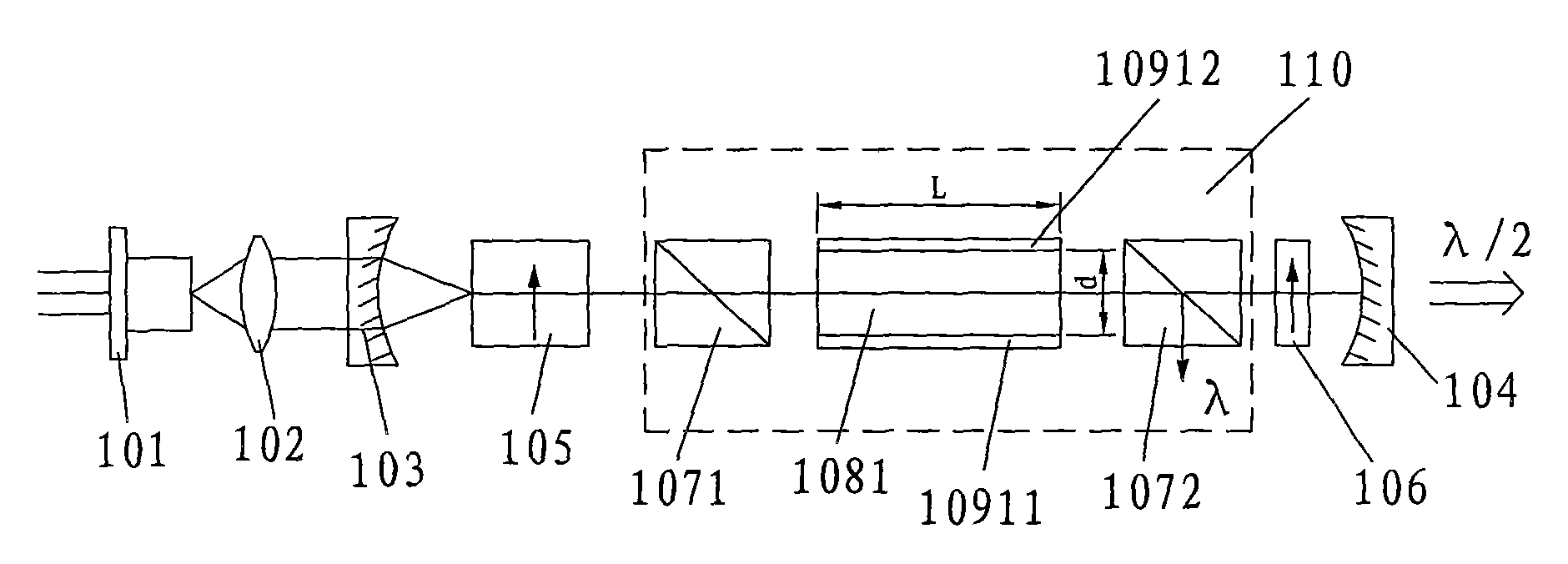Demodulating method for realizing laser intracavity frequency doubling light and laser structure thereof
A technology of intracavity frequency doubling and modulation method, which is applied in the laser field, can solve the problems of limited modulating frequency range, loss of laser energy, difficulty in large-scale productization, etc., achieve simple and convenient wide frequency range adjustment, and overcome the limitation of modulation range Effect
- Summary
- Abstract
- Description
- Claims
- Application Information
AI Technical Summary
Problems solved by technology
Method used
Image
Examples
Embodiment 1
[0031] Referring to shown in Fig. 1 (a), the pumping light of semiconductor laser pumping source 101 enters the resonator that pump is made up of resonator mirror 103 and 104 through optical coupling system 102, is provided with laser gain medium 105 in the resonator, to A fine-tuning system for fundamental wave light loss and a frequency doubling crystal 106.
[0032] The fine-tuning system is an electro-optic crystal 1081 with electrode plates 10911 and 10912 on the upper and lower sides of the non-optical surface, and the electro-optic crystal 1081 is modulated by adjusting the voltage of the electrode plates 10911 and 10912. The electro-optic crystal 1081 is set on the polarizer Between the device 1071 and the analyzer 1072. The electro-optic crystal 1081 can be LN crystal, BBO crystal, KTP crystal. The length of the electro-optic crystal 1081 in the light-passing direction is L, the height is d, and voltage is applied on both sides of the light-passing section. Since th...
Embodiment 2
[0036] Referring to shown in Fig. 1 (b), the pumping light of semiconductor laser pumping source 101 enters the resonator that pump is made up of resonator mirror 103 and 104 through optical coupling system 102, is provided with laser gain medium 105 in the resonator, to A fine-tuning system for fundamental wave light loss and a frequency doubling crystal 106.
[0037] The fine-tuning system is that an electromagnetic field 1092 is applied around the non-transmissive surface of a magneto-optic crystal 1082, and the magneto-optic crystal 1082 is modulated by adjusting the magnetic field of the electromagnetic field 1092. The magneto-optic crystal 1082 is arranged on the polarizer 1071 and the detector. Between polarizers (1072). Since the required rotation angle is small, the applied magnetic field strength can be small or the required crystal length can be relatively large. For some magneto-optical materials, especially materials with a light-transmitting wavelength range of ...
Embodiment 3
[0039]Referring to shown in Fig. 1 (c), the pumping light of semiconductor laser pumping source 101 enters the resonator that pump is made up of resonator mirror 103 and 104 through optical coupling system 102, is provided with laser gain medium 105 in the resonator, to A fine-tuning system for fundamental wave light loss and a frequency doubling crystal 106. The fine-tuning system is adjustable etalon 1083 .
PUM
 Login to View More
Login to View More Abstract
Description
Claims
Application Information
 Login to View More
Login to View More - R&D
- Intellectual Property
- Life Sciences
- Materials
- Tech Scout
- Unparalleled Data Quality
- Higher Quality Content
- 60% Fewer Hallucinations
Browse by: Latest US Patents, China's latest patents, Technical Efficacy Thesaurus, Application Domain, Technology Topic, Popular Technical Reports.
© 2025 PatSnap. All rights reserved.Legal|Privacy policy|Modern Slavery Act Transparency Statement|Sitemap|About US| Contact US: help@patsnap.com



